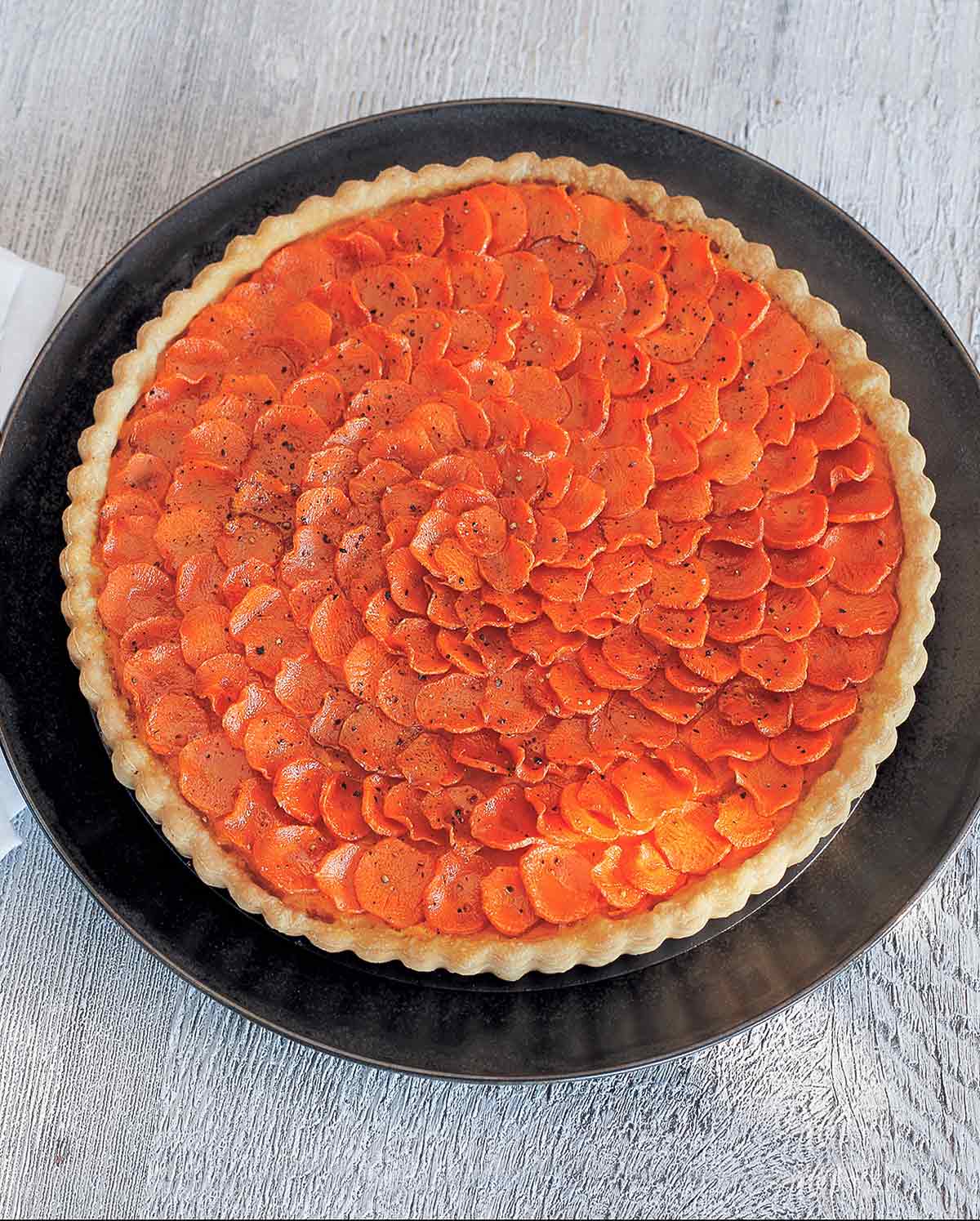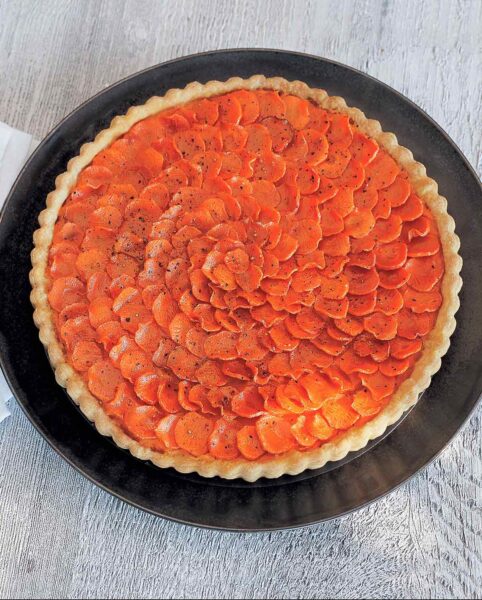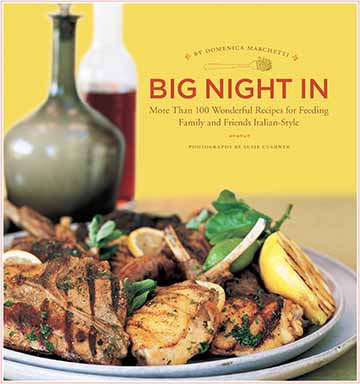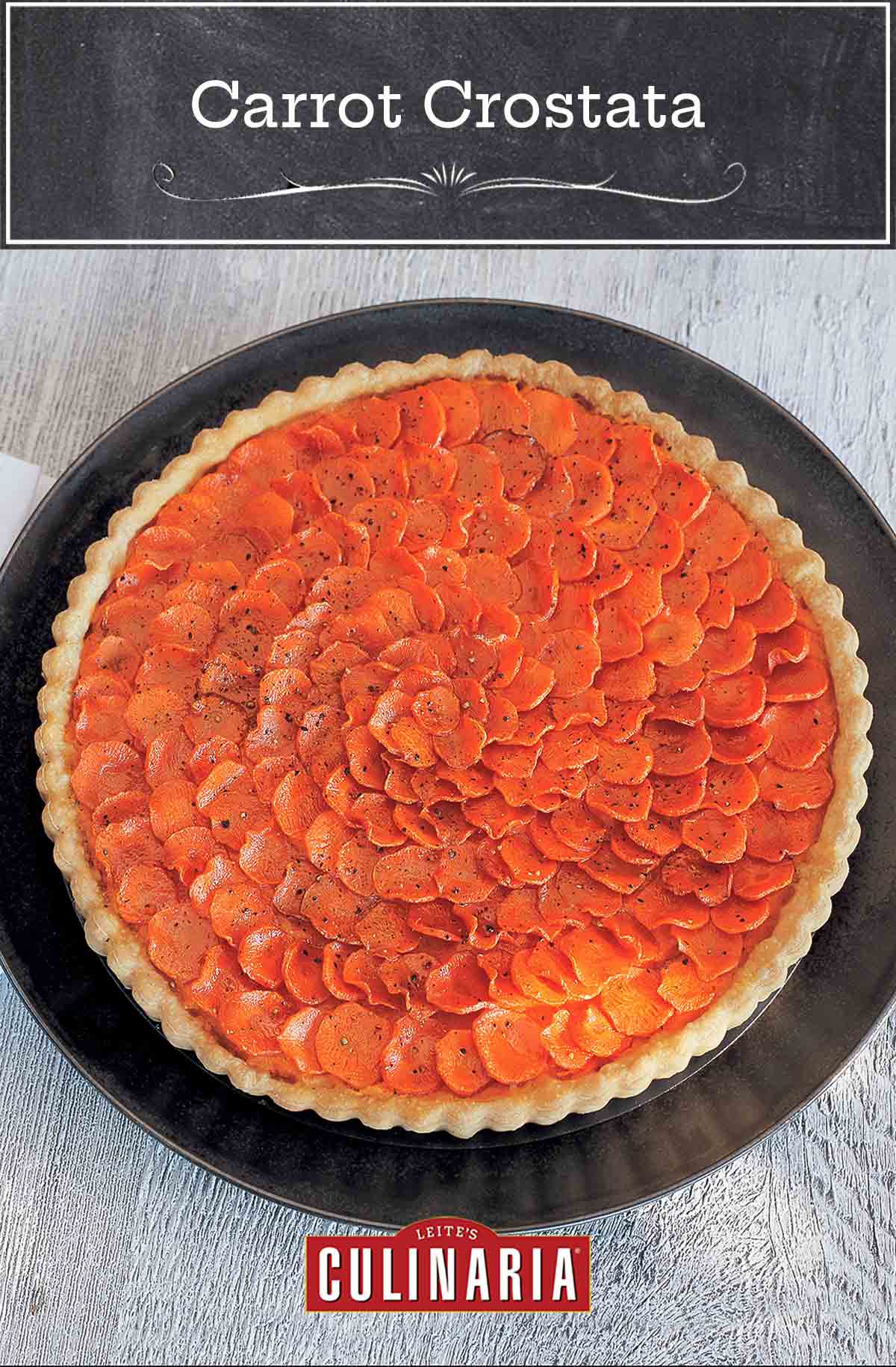
Carrots are essential to Italian cooking. Minced finely with celery, onion, and parsley, they make what is known as a “battuto.” When sauteed in olive oil, this mixture becomes a “soffritto,” and forms the base of countless Italian dishes. In my cookbooks, I have sought to raise the carrot’s profile beyond its role as a foundation vegetable by featuring it in numerous recipes. This recipe is a little labor-intensive by today’s standards but is, without a doubt, worth the time and the effort.—Domenica Machetti
Carrot Crostata FAQs
A blind-baked crust will often shrink or slump because of the fat content and the fact that it’s empty doesn’t help either. Crimping your edges a little higher helps to maintain some height but the most important thing you can do is use pie weights (or dried beans or even sugar). Make sure that you’re using enough to fill the crust—that way, the sides get the support they need to keep from slumping and shrinking.
You’re going to be slicing the carrots for both the purée and the coins for the top. Keep in mind that the size of the slices will affect the cooking time. For the purée, just be sure that they’re cut uniformly, so they cook evenly. For the top of the crostata, 1/4 inch slices are a good size. Remember that they’ll shrink as they cook and really thin slices will burn around the edges.

Carrot Crostata
Equipment
- 11-inch fluted tart pan
Ingredients
For the tart dough
- 1 1/3 cup unbleached all-purpose flour, plus more for the work surface
- 1/2 teaspoon salt
- 1 stick (4 ounces) unsalted butter, cold, cut into 1/2-inch dice
- 4 tablespoons ice water
For the tart filling
- 2 3/4 pounds carrots, peeled and trimmed
- 1 small yellow onion, thinly sliced or chopped
- 3 1/2 to 4 cups homemade chicken stock or best quality fat-free, low-sodium canned chicken broth or homemade vegetable broth
- 6 tablespoons unsalted butter
- 2 large egg yolks
- 1 cup freshly grated Parmigiano-Reggiano
- Kosher or sea salt to taste
- Freshly ground black pepper to taste
Instructions
Make the tart dough
- Dump the flour and salt in the work bowl of a food processor and pulse briefly to combine. Sprinkle with the butter and process until the mixture is crumbly. Add just enough water through the feed tube to make the dough come together. Turn the dough out onto a lightly floured surface and pat it into a disk. Wrap in plastic and refrigerate for at least 30 minutes and up to 2 days in advance. (Remove the tart dough from the refrigerator and let it come to slightly cooler than room temperature before rolling it out.)
- Roll the dough out into a 14-inch circle, again on a lightly floured surface. Carefully wrap the dough around the rolling pin and drape it over an 11-inch fluted tart pan with a removable bottom. Gently press the dough into the bottom and up the sides of the pan. Trim the overhanging dough to about 1/2 inch, fold it in over the side of the pan, and press it to reinforce the side of the tart. Use the rolling pin or the flat of your hand to press around the perimeter of the pan to cut off any excess dough. Place the tart pan in the refrigerator for 30 minutes.
- Preheat the oven to 400°F (200°C).
- Remove the tart pan from the refrigerator and line it with a piece of heavy-duty aluminum foil (or 2 pieces of regular aluminum foil to create a double thickness). Fill the lined shell with pie weights or dried beans and bake for 20 minutes. Remove the aluminum foil and the beans and bake for 10 to 15 more minutes, until the crust is light golden. Move the pan to a rack to cool. Reduce the oven temperature to 375°F (190°C).
Make the tart filling
- Select half of the carrots—choose the least attractive ones—and slice them into thick coins. Reserve the remaining carrots for the spiral surface of the tart. Place the cut carrots in a large saucepan with the onion and just enough broth to cover (you should have some broth left). Bring the broth to a simmer over medium-high heat, reduce the heat to medium-low, cover the pan, and gently cook the carrots for 30 minutes. Uncover and cook for an additional 15 to 20 minutes, or until the carrots are very tender and almost all of the liquid has evaporated. Let cool for 10 minutes.
- Dump the cooked carrots and any liquid remaining in the pan into a blender and purée until smooth, adding an extra splash of broth if necessary to loosen the mixture just enough to puree it. Pour the purée into a skillet or sauté pan placed over medium-low heat. Cook briefly, stirring frequently with a wooden spoon or spatula, until the purée is thick and any liquid has evaporated. Remove from the heat and stir in 2 tablespoons of butter. Whisk in the egg yolks and Parmigiano cheese and season to taste with salt and pepper.
- Cut the reserved carrots into thin, uniform coins. Melt 2 tablespoons of butter in a large skillet or wide sauté pan over medium-low heat. When the butter has melted, add the carrots and sprinkle with a little salt and pepper. Cook the carrots over medium-low to low heat for about 30 minutes, or until they're just tender, moistening them from time to time with a splash of broth to prevent them from sticking to the bottom of the pan. Remove the pan from the heat and let the carrots sit until cool enough to touch.
Assemble the tart
- Spread the carrot purée over the baked tart crust. Arrange the carrot coins on top of the purée in slightly overlapping concentric circles, beginning at the outer edge of the tart and ending at the very center. Gently brush the top of the tart with any liquid remaining in the pan in which the carrot coins were sautéed and then dot the surface of the tart with the remaining 2 tablespoons of butter, cut into small pieces.
- Bake the tart for about 20 minutes, until the filling is heated through and the top is very lightly browned. Move the tart pan to a wire rack to cool for 10 minutes. Remove the tart ring and place the tart on a serving platter. Serve warm. This tart is best the day it's made, although it may be baked several hours in advance and kept at room temperature. Just before serving, reheat it in a 350°F (175°C) oven until warmed through.

Explore More with AI
Nutrition
Nutrition information is automatically calculated, so should only be used as an approximation.
Recipe Testers’ Reviews
I liked this crostata very much. The dough bakes up flaky, and the filling is savory and delicious. It’s one of those rare dishes that satisfies vegetarians as well as carnivores. It also makes a beautiful presentation if you take the time to slice and arrange the carrot topping.
This is a beautiful presentation that’s worth the non-trivial amount of work it takes to make it. The filling is rich with the flavor of onions and Parmesan, and the color is great. It’s a great item for a buffet or dinner party, as well as holiday fare.
One of the star elements of this carrot crostata is the crust itself. With a total butter and flour combination, the crust came together perfectly. It’s important to remember that part of the success of making this dough is to freeze it according to the required directions. This step will prevent the butter from melting too quickly and later shrinking from the sides of the tart pan when in the oven. But when baked, the tart turned had a delectably flaky and golden crust for the sweet filling.
Although this recipe is time-intensive, it received rave reviews from my family. Admittedly, we’re carrot lovers, so I was confident from the start that this tart would be well-received. What I loved most about the carrot filling was combining the purée with Parmesan cheese, butter, and eggs. They added a rich decadence that was almost candy-like to taste. It was a palate-pleaser through and through. What a fabulous addition to a holiday table or even a party food for hungry nibblers.











What do you think of making this crustless? (I am eating low carb, boo hoo)
Ellen, we haven’t tested this without the crust but I’m sure you could make it successfully. I would use a casserole or pie dish and make the filling as directed. If you try it, please do let us know how it turns out.